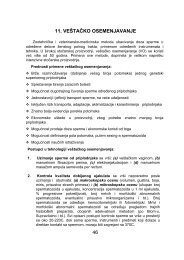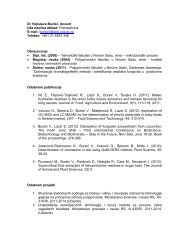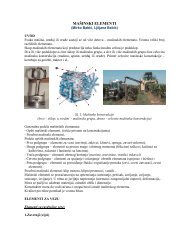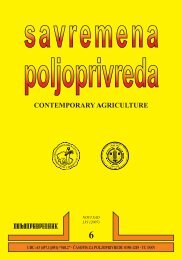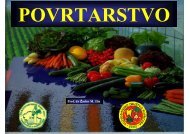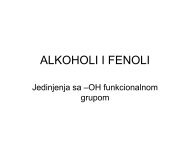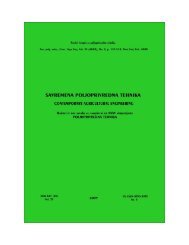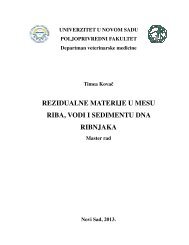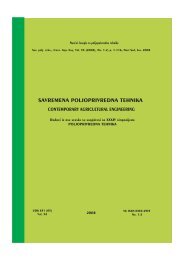2008 Savremena poljoprivreda 57 1-2.indd - Poljoprivredni fakultet ...
2008 Savremena poljoprivreda 57 1-2.indd - Poljoprivredni fakultet ...
2008 Savremena poljoprivreda 57 1-2.indd - Poljoprivredni fakultet ...
Create successful ePaper yourself
Turn your PDF publications into a flip-book with our unique Google optimized e-Paper software.
gene expression has been reported in several multiple lines of transgenic animals including<br />
mouse and pigs (Chen et al., 2002, Van Cott et al., 1997). Our results correspond to<br />
data of earlier studies.<br />
Transgenic females, no.116 and no.117, showed gradual increase of milk production<br />
until day 20th, afterwards it was decreased next 10 days upon the end of experiment (Table<br />
1). No signifi cant differences were obtained between transgenic and non-transgenic females<br />
at the fi rst lactation.<br />
Milk production of transgenic females was comparable with those of non-transgenic<br />
does. Schranner (1993) reported similar results (day 10– 0.18 kg, day 20– 0.21 kg, day<br />
30– 0.17 kg), and this observation is in agreement with previously published reports of other<br />
authors (Dragin et al., 2004).<br />
In milk samples from both lactating transgenic females from F3 generation, Westernblotting<br />
analysis revealed a 21 kDa specifi c band, which corresponds to a light chain of<br />
rhPC.<br />
The concentrations of rhPC produced in the mammary gland of both transgenic females<br />
from F3 generation, determined by ELISA, ranged within 0.109 to 0.351 μg/ml depending<br />
on lactation day (Table 2). No signal was detected in milk of non-transgenic female.<br />
However, the concentration of rhPC in mammary gland of transgenic rabbit females<br />
was low, similarly to F1 and F2 generation (Table 3) of transgenic rabbits (Chrenek et al.<br />
2002). The concentration of recombinant hPC is changing concomitantly with change in<br />
milk yield during lactation, with peak on 20th day of lactation.<br />
Concentration of rhPC in milk among different generations and even among animals<br />
within the same generation was highly variable (for instance, F2 generation 0.030–0.375<br />
μg/ml). This means that transgene expression is individual parameter of each female. It is<br />
possible that such variability is due to different copy number of transgene or localization<br />
of transgene on the chromosome. Otherwise, it may be affected by different milk yield,<br />
eventually different milk composition (content of fat, proteins and other), which can interfere<br />
with proper measurement of rhPC.<br />
Van Cott et al. (2001) using different hPC gene construct, obtained rhPC secretion in<br />
transgenic pig milk, in range of 40 to 1200 μg/ml. He also suggested that pigs with rhPC<br />
expression levels less than 500 μg/ml had no signifi cant differences in milk protein composition<br />
compared to non-transgenic pigs. Same authors concluded that transgenesis and<br />
rhPC secretion in milk was not related to any abnormality of milk production such as mastitis<br />
or other mammary gland disorders.<br />
CONCLUSIONS<br />
In conclusion, present study confi rms stability of hPC transgene transmission and proves<br />
that rhPC can be steadily secreted over multiple generations with no interference on<br />
milk production.<br />
REFERENCES<br />
CHEN C.M., WANG C.H., WU S.C., LIN C.C., LIN S.H., CHENG W. T. K.: Temporal and spatial<br />
expression of biologically active human factor VIII in the milk of transgenic mice driven by mammary-specifi<br />
c bovine alfa-lactalbumin regulation sequences. Transgenic Res. 11, 2<strong>57</strong>–268, 2002.<br />
134




